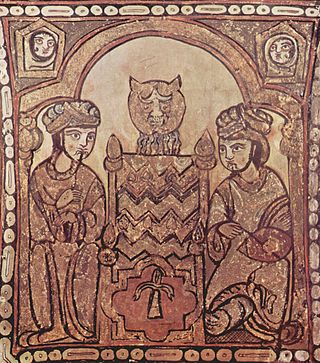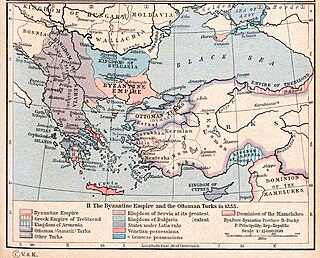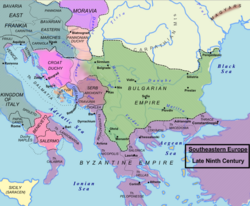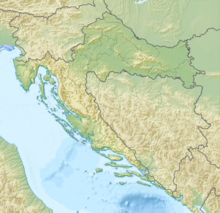
Saracen was a term used both in Greek and Latin writings between the 5th and 15th centuries to refer to the people who lived in and near what was designated by the Romans as Arabia Petraea and Arabia Deserta. The term's meaning evolved during its history of usage. During the Early Middle Ages, the term came to be associated with the tribes of Arabia.

Zachlumia or Zachumlia, also Hum, was a medieval principality located in the modern-day regions of Herzegovina and southern Dalmatia. In some periods it was a fully independent or semi-independent South Slavic principality. It maintained relations with various foreign and neighbouring powers and later was subjected to Kingdom of Hungary, Kingdom of Serbia, Kingdom of Bosnia, and at the end to the Ottoman Empire.

The Catepanateof Italy was a province of the Byzantine Empire from 965 until 1071. At its greatest extent, it comprised mainland Italy south of a line drawn from Monte Gargano to the Gulf of Salerno. North of that line, Amalfi and Naples also maintained allegiance to Constantinople through the catepan. The Italian region of Capitanata derives its name from katepanikion.
The History of Dalmatia concerns the history of the area that covers eastern coast of the Adriatic Sea and its inland regions, from the 2nd century BC up to the present day. The region was populated by Illyrian tribes around 1,000 B.C, including the Delmatae, who formed a kingdom and for whom the province is named. Later it was conquered by Rome, thus becoming the province of Dalmatia, part of the Roman Empire. Dalmatia was ravaged by barbaric tribes in the beginning of the 4th century.

The Republic of Ragusa was an aristocratic maritime republic centered on the city of Dubrovnik in South Dalmatia that carried that name from 1358 until 1808. It reached its commercial peak in the 15th and the 16th centuries, before being conquered by Napoleon's French Empire and formally annexed by the Napoleonic Kingdom of Italy in 1808. It had a population of about 30,000 people, of whom 5,000 lived within the city walls. Its motto was "Non bene pro toto libertas venditur auro", a Latin phrase which can be translated as "Liberty is not well sold for all the gold".

Longobardia was a Byzantine term for the territories controlled by the Lombards in the Italian Peninsula. In the ninth and tenth centuries, it was also the name of a Byzantine military-civilian province known as the Theme of Longobardia located in southeastern Italy.

The history of Islam in Sicily and southern Italy began with Arab colonization in Sicily, at Mazara, which was captured in 827. The subsequent rule of Sicily and Malta started in the 10th century. The Emirate of Sicily lasted from 831 until 1061, and controlled the whole island by 902. Though Sicily was the primary Muslim stronghold in Italy, some temporary footholds, the most substantial of which was the port city of Bari, were established on the mainland peninsula, especially in mainland southern Italy, though Arab raids, mainly those of Muhammad I ibn al-Aghlab, reached as far north as Naples, Rome and the northern region of Piedmont. The Arab raids were part of a larger struggle for power in Italy and Europe, with Christian Byzantine, Frankish, Norman and indigenous Italian forces also competing for control. Arabs were sometimes allied with various Christian factions against other factions.

The Muslim conquest of Sicily began in June 827 and lasted until 902, when the last major Byzantine stronghold on the island, Taormina, fell. Isolated fortresses remained in Byzantine hands until 965, but the island was henceforth under Muslim rule until conquered in turn by the Normans in the 11th century.
The Emirate of Bari was a short-lived Islamic state in Apulia, in what is now Italy, ruled by non-Arabs, probably Berbers and Black West Africans. Controlled from the South Italian city of Bari, it was established about 847 when the region was taken from the Byzantine Empire, but fell in 871 to the army of the Carolingian emperor Louis II.

Niketas Oryphas or Oöryphas was a distinguished Byzantine official, patrikios, and admiral under the Byzantine emperors Michael III and Basil I the Macedonian, who achieved several naval victories against the Cretan Saracen raiders.

Events from the 9th century in, or regarding, Historic Serbia or Serbs.

The Battle of Stelai was a naval battle fought in 880 between the Byzantine and Aghlabid fleets off the southern Italian peninsula. The battle was a major Byzantine victory. Its location is disputed, hence it is also known as the First Battle of Milazzo or the Battle of Punta Stilo in modern literature.

The Battle of Cephalonia was a naval battle fought between the Byzantine and Aghlabid fleets near Cephalonia, off the western coast of Greece. The battle was a major Byzantine victory, and one of the rare naval battles that took place during the night in the Middle Ages.

The Battle of Kardia was a naval battle fought in c. 872/3 between the fleets of the Byzantine Empire and the Cretan Saracens off Kardia, in the Gulf of Saros. The battle was a major Byzantine victory.
Photios was a Byzantine renegade and convert to Islam who served the Emirate of Crete as a naval commander in the 870s.

The Battle of the Straits was fought in early 965 between the fleets of the Byzantine Empire and the Fatimid Caliphate in the Straits of Messina. It resulted in a major Fatimid victory, and the final collapse of the attempt of Emperor Nikephoros II Phokas to recover Sicily from the Fatimids.
Al-Hasan ibn Ali ibn Abi al-Husayn al-Kalbi, known in Byzantine sources as Boulchasenes and Aboulchare (Ἀβουλχαρέ), was the first Kalbid Emir of Sicily. A member of an aristocratic family within the ruling circle of the Fatimid Caliphate, he helped suppress the great revolt of Abu Yazid in 943–947 and was sent as governor of Sicily from 948 until 953, when he returned to Ifriqiya. He was succeeded in Sicily by his son Ahmad ibn al-Hasan al-Kalbi, but led several campaigns in Sicily and southern Italy against the Byzantines in 955–958, as well as the raid against Almeria that sparked a brief conflict with the Caliphate of Córdoba in 955. He died at Palermo in 964, during another campaign against the Byzantines.

The Frankish emperor Louis II campaigned against the Emirate of Bari continuously from 866 until 871. Louis was allied with the Lombard principalities of southern Italy from the start, but an attempt at joint action with the Byzantine Empire failed in 869. In the final siege of the city of Bari in 871, Louis was assisted by a Slavic fleet from across the Adriatic.

The siege of Salerno was one of the campaigns of the Aghlabids in southern Italy during their conquest of Sicily. The Lombard city of Salerno had strong defences and, despite the use of stone-throwing artillery, the siege lasted a little over a year from its beginning in late 871 or early 872. Prince Guaifer of Salerno led the defence, but the siege was only lifted by the arrival of an army of Lombards and Franks under the Emperor Louis II.














